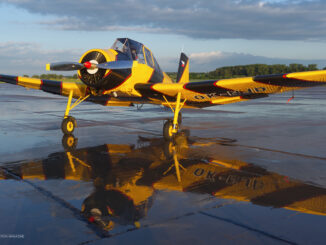 Bellanca 7GCBC Citabria (c/n 215-70, OK-LOL), taxiing for take-off during the 32nd edition of Aviatická pouť air show, Pardubice, June 2024.
Bellanca 7GCBC Citabria (c/n 215-70, OK-LOL), taxiing for take-off during the 32nd edition of Aviatická pouť air show, Pardubice, June 2024.
The story of Citabria aircraft began in the mid-1940s, when Aeronca Company (contracted from Aeronautical Corporation of America) from Middletown, Ohio, introduced into the market its Model 7AC Champion aeroplane.
The aircraft was developed as the direct competitor to Piper Cub, the then popular light utility aeroplane widely used by military and civilian operators. The Champion, commonly nicknamed ´Champ´ or ´Airknocker´, entered production in the late 1945.
The Model 7 quickly became the commercial success and thousands of examples of the aeroplane were sold by 1950, when the light aviation market was struck by the first post-war crisis. Until that time, Aeronca developed several upgraded variants of the aeroplane, successively designated 7BCM, 7DC and 7EC, as well as military versions labelled L-16, L-16A and L-16B.
In 1951, Aeronca ceased production of the light aeroplanes and three years later, rights to manufacture the Champion were acquired by newly established Champion Aircraft Corporation from Osceola, Wisconsin. The new entity not only manufactured aircraft from the original Model 7 series, but also continued their development into more advanced variants and finally designing the aerobatic-capable one, known as Champion Citabria.
The first aeroplane from the Citabria family, designated 7ECA, was introduced into the market in 1964. Next year, it was followed by 7GCAA and 7GCBC variants and, finally, by 7KCAB in 1968.
The Citabria had retained the basic design characteristics of the initial Aeronca aircraft – the single engine, high-wing monoplane with strut-supported wings, two seats in tandem configuration and conventional, fixed landing gear. Its fuselage and tail section were made of welded metal tubes, supported by wooden longerons and covered with fabric. Initially, the 7ECA model was powered by 100 hp Continental O-200-A engine, later changed to more powerful Lycoming O-235 series, generating 115 hp.
The 7GCBC variant (also, in later years, marketed as Citabria 150S, Citabria C or Citabria Explorer), introduced in 1965, was powered by 150 hp Lycoming O-320 engine. In addition, the aircraft featured wood-spar wings – instead of aluminium spars used with the 7ECA – one-foot longer wingspan and spring steel main gear legs.
At the moment the Citabria entered the market, it was the sole commercial certified aircraft in the United States capable of aerobatics. The aeroplane quickly became very popular for training purposes, bush flying and various agricultural tasks, as well as glider towing. The 7GCBC was also acquired by the Turkish Army and used as observation aeroplane.
In 1970, Champion Aircraft Corporation was taken over by Bellanca Aircraft. The new company continued with production of all Champion-designed models, as well as added two new aircraft to the family – 8KCAB Decathlon and 8GCBC Scout. However, in the early 1980s, Bellanca Aircraft Corporation ceased its activity.
Over the next years, rights to produce the Champion/Bellanca aircraft often changed the owner. Finally, in 1989, all the designs were purchased by American Champion Aircraft Corporation (not related to the former Champion Aircraft Corporation). Production of Citabria, Decathlon and Scout aeroplanes was re-launched in 1990 and is being continued until today.
It is estimated that grand total of aircraft from the Champion family, manufactured altogether by Aeronca, Champion and Bellanca, exceeds 10,000 examples. This made the Champion aeroplanes one of the most popular and the longest manufactured light aircraft in the world.



